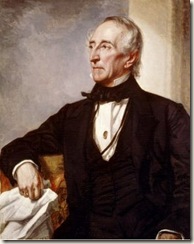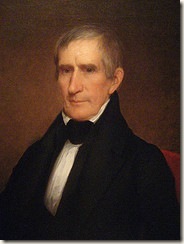 John Tyler was born into an aristocratic Virginian family. He studied law under his father (who went on to be the Governor of Virginia) and passed the bar at the age of 19. At 21 he was elected to the Virginia House of Delegates. From then on, he almost continually held an elected position: U.S. Representative, Governor of Virginia, U.S. Senator.
John Tyler was born into an aristocratic Virginian family. He studied law under his father (who went on to be the Governor of Virginia) and passed the bar at the age of 19. At 21 he was elected to the Virginia House of Delegates. From then on, he almost continually held an elected position: U.S. Representative, Governor of Virginia, U.S. Senator.
Politically Tyler was a strict constructionist when it came to interpreting the Constitution. If the Constitution did not explicitly give the power to the federal government, then it belonged to the states. He was an outspoken critic of the John Quincy Adams administration wanting to spend federal money on infrastructure projects, like roads and bridges. He was also against federal regulation of commerce and agriculture. When he first met Andrew Jackson, he believed that he had found someone of a like mind and supported Jackson’s election in 1828. Once Jackson became president, Tyler helped him to kill the charter for the 2nd Bank of the United States. However they had a falling out when Jackson removed government funds from the bank. Tyler felt that this action was unconstitutional. In fact, he felt that Jackson’s excessive use of federal authority was unconstitutional. He opposed the Force Bill that would have given Jackson the right to send federal troops into South Carolina.
By this time, Tyler split from the Jackson camp and aligned himself more with the new Whig party started by Henry Clay. By 1836, Tyler’s dislike of Jackson was so terrible that when Congress was debating removing the censure of Jackson, Tyler resigned his seat instead of following the instructions from the Virginia Legislature. During the presidential election of 1836, he ran as a vice-presidential candidate for W. H. Harrison in some states and for Hugh White in other states.
During the 1840 election campaign there were rumors about Harrison’s health problems. After the inauguration, Tyler only stayed in D.C. long enough to be sworn in and to preside over the Senate during confirmation of Harrison’s cabinet. He then headed back to his home in Virginia. On April 1st, he started to get messages that Harrison had taken a turn for the worst, but stayed on in Virginia, not wanting to look like a vulture waiting for Harrison to die. He was not surprised then when the message arrived that Harrison had died and he was to become president. As the first of the “accidental” presidents, John Tyler was acutely aware that much of what he did first would be setting a precedent.
Tyler had reviewed the Constitution’s wording on what happened when the president died. He knew that what exactly it meant would be up for debate. Would he only be president until a special election could be held? Was he the president until the end of Harrison’s term? Did he have all the powers of the president? When he got to D.C., he made sure that Harrison’s cabinet was present during the swearing-in ceremony. He then called the cabinet into a special cabinet meeting. Harrison had taken the view that major decisions would be made by consensus of the cabinet. Taylor made it clear that this would change. He told the cabinet “I am the president and I shall be held responsible for my Administration. I shall be pleased to accept your counsel and advice. But I can never consent to being dictated to… When you think otherwise your resignation will be accepted.” Tyler’s independence really angered the leadership of the Whig party (including Henry Clay) who had been expecting to control Harrison.
One of the first bills that the Whig-controlled Congress tried to push through would have re-chartered the 2nd Bank of the United States. Tyler was opposed to the Bank and vetoed the bill. The Whigs pushed through another bill that was essentially the same thing. After the second veto, his entire cabinet resigned (except his Secretary of State Daniel Webster). Tyler moved quickly to replace the cabinet members. After vetoing a series of tariff bill that he believed were unconstitutional, the House of Representatives attempted to impeach him. The vote failed by a large margin.
The only other things of significance that happened during his presidency happened near the end. He had been lobbying to try and annex Texas. Naturally, the issue of slavery continued to be brought into the discussion. Tyler signed a treaty with Sam Houston, the President of the Republic of Texas. However all treaties have to be approved by 2/3 of the Senate. This one failed to be ratified by the Senate. In a procedural maneuver, Tyler decided that Texas could be annexed through a joint resolution which only required a simple majority. This passed the Senate by 2 votes.
On a more personal side, in Feb 1844, he was leading a group of senior military and state department staff on a tour of the USS Princeton. During the tour, one of the main guns exploded killing several people to include his Secretary of the Navy, Abel Upshur (his Secretary of State), and his future father-in-law David Gardiner.
Tyler made an attempt to run for reelection in 1844, but it became clear that he was too unpopular and did not have the support of a major party so he dropped out of the race.
- John Tyler is the first president born after the signing of the Constitution
- Tyler is the president that had the most children: 15! Eight from his first wife and 7 from his second wife.
- Tyler was 70 years old when his last child (Pearl) was born. She lived until 1947. It was almost 160 years from the time her father was born until she died!
- As of March 2011, Tyler has two living grandsons through his son Lyon
- He was the first president to get married while in the White House. His children from his first marriage did not approve and didn’t attend the wedding.
- He is considered the traitor president. Tyler was elected to the Confederate Congress in 1862, but died before taking office.
- The only president to have held the office of the President pro tempore of the Senate
- The 1,600 acre farm that Tyler bought is still in the Tyler family and is still a working farm. Some believe that his second wife, Julia Gardner, haunts the house.
- With the resignation of Webster over the Texas annexation, the death of Upshur on the Princeton, and the appointment of John Calhoun, Tyler had 3 different Secretaries of State in under a year
- Tyler is considered by some to be the only president to have died outside the U.S., since he passed away in Richmond, Virginia, which was part of the Confederate States
Vital Stats:
- Wife: Letitia Christian (Married 1814-1842), Julia Gardner (Married 1844-1862)
- Children: 8 sons, 7 daughters
- Party affiliation: Democratic Party (1825-1834), Whig (1834-1841), independent (1841-1862)
- Presidency: 1841-1844
- Born: March 29th, 1790 (Greenway, Virginia)
- Died: January 18th, 1862 (Richmond, Virginia)
